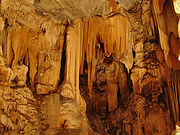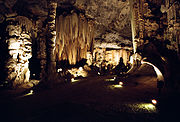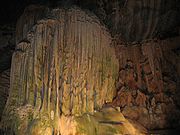
Cango Caves
Encyclopedia



Precambrian
The Precambrian is the name which describes the large span of time in Earth's history before the current Phanerozoic Eon, and is a Supereon divided into several eons of the geologic time scale...
limestone
Limestone
Limestone is a sedimentary rock composed largely of the minerals calcite and aragonite, which are different crystal forms of calcium carbonate . Many limestones are composed from skeletal fragments of marine organisms such as coral or foraminifera....
s at the foothills of the Swartberg
Swartberg
The Swartberg mountains make up a mountain range that runs roughly east-west along the northern edge of the semi-arid Little Karoo in the Western Cape province of South Africa...
range near the town of Oudtshoorn in the Western Cape
Western Cape
The Western Cape is a province in the south west of South Africa. The capital is Cape Town. Prior to 1994, the region that now forms the Western Cape was part of the much larger Cape Province...
Province of South Africa
South Africa
The Republic of South Africa is a country in southern Africa. Located at the southern tip of Africa, it is divided into nine provinces, with of coastline on the Atlantic and Indian oceans...
. The principal cave is one of the country's finest, best known and most popular tourist caves and attracts many visitors from overseas. Although the extensive system of tunnels and chambers go on for over four kilometers, only about a quarter of this is open to visitors, who may proceed into the cave only in groups supervised by a guide. Tours are conducted at regular intervals on most days - there is a "Standard Tour" which takes an hour and an "Adventure Tour" which takes an hour and a half. The "Adventure Tour" consists of crawling through narrow passages and climbing up steep rock formations guided by small lights. The caves contain spectacular halls and grand limestone formations (on both tours) as well as some rather small passages on the Adventure Tour. The smallest passage that tourists will have to pass through on the Adventure Tour is just under 30 cm high at the exit.
The caves are considered to be part of the Garden Route
Garden Route
The Garden Route is a popular stretch of the south-eastern coast of South Africa. It stretches from Heidelberg in the Western Cape to the Storms River which is crossed along the N2 coastal highway over the Paul Sauer Bridge in the extreme western reach of the neighbouring Eastern Cape...
.
History
Prof. A.J.H. Goodwin (UCTUniversity of Cape Town
The University of Cape Town is a public research university located in Cape Town in the Western Cape province of South Africa. UCT was founded in 1829 as the South African College, and is the oldest university in South Africa and the second oldest extant university in Africa.-History:The roots of...
archaeologist) carried out a test excavation in the Cango Caves in 1930. Stone artefacts and other cultural material show people had been living in the entrance to the caves over a long period during the Middle and Later Stone Ages.
The caves were discovered in 1780 by a local farmer named Jacobus Van Zyl. The chamber he first was lowered down into (Van Zyl Hall, which is as long as a football field), is named in his honor.
Further exploration was done and a second chamber discovered in 1792. The caves soon became a popular place to visit.
Legends of the caves
Mr. Johnny van Wassenaer, the cave’s first official guide is purported to have walked 29 hours to find the end of the caves in 1898. When there, he is said to have calculated that he was 25 km from the entrance, and 275m under ground. His route apparently followed an underground river. So far, no caves have been found to support this story.Surveys and explorations
The first rough survey was done in 1897, mapping out the first 26 chambers. In 1956 the South African Spelaeological Association was tasked to draw up an accurate mapping of the Cango Caves, and look for alternative entrances.Their results indicated that the caves were 775m long in a single line, and that they never rise nor fell more than 16m. These were called Cango I. The nearest point to the surface in the caves is at the top of the shaft in the Devil's Kitchen, 52.6m from the floor.
In 1972 James Craig-Smith, Luther Terblanche and Dart Ruiters widened an obstructed passage to discover Cango II. It stretches 270m beyond the end of the Devil’s Kitchen. At the end of Cango II there is a shaft that descends 20m to a chamber filled with water. This water flowed in the direction of Cango I.
In August 1975, during a symposium on cave biology, an exploration team led by Florus Koper drained the chamber of most of its water and crawled through what was previously an underwater passage. This led to the discovery of more caves, called Cango III. Altogether these caves are about 1000m long. The biggest of the chambers, stretches about 300m.
Digby Ellis and Dave Land added 290m to Cango III when they discovered a crawlway in December 1977. A further 90m was added in June 1978. All these extensions were surveyed in August 1978 by Dave Land, Charles Maxwell, Brian Russell and Dave Crombie.

